The highlight of my December 2019 trip was no doubt a week-long road trip through the South Island of New Zealand.
Driving one’s way across New Zealand makes for one of the world’s quintessential journeys by road, and the usual traveller’s recommendation is to divide your time between the North and South Islands.
With limited time on our hands on this trip, though, we decided to dedicate this trip mostly to the dramatic landscapes of the South Island, saving the more urbanized North Island for next time.
Here’s the recap from a highly memorable road trip in one of my favourite countries in the world, told through a series of photos that highlight the South Island’s stunning natural beauty.
The Itinerary
Jessy and I spent a fair bit of time crafting our itinerary for this road trip, with the aim of seeing as many of the South Island’s significant points of interest as possible, while never feeling too rushed and keeping our driving time limited to at most three or four hours per day.
The itinerary we settled on looked as follows:
-
Day 1: Arrive in Auckland at night
-
Day 2: Exploring Auckland
-
Day 3: Exploring Auckland; fly to Queenstown at 3pm; drive to Te Anau (2.5 hour drive); stay at an Airbnb
-
Day 4: Boat cruise & hike of Milford Sound, booked through GetYourGuide
-
Day 5: Hiking around Lake Te Anau; drive back to Queenstown (2.5 hour drive); stay overnight at the Hilton Queenstown
-
Day 6: Exploring Queenstown; drive to Lake Pukaki (3 hour drive); stay at an Airbnb
-
Day 7: Hiking Mount Cook (1 hour drive each way)
-
Day 8: Exploring Lake Tekapo (1 hour drive each way)
-
Day 9: Drive back to Queenstown (3 hour drive); stay at the Hilton Queenstown
-
Day 10: Exploring Queenstown; begin the return journey home
The main idea behind this itinerary was to use Queenstown as a home base for our time in the South Island, and to drive separately to two smaller bases a few hours to the south and north of Queenstown: Te Anau, a small town that acts as the gateway to Milford Sound; as well as Lake Pukaki, the spot where the roads to Mount Cook and Lake Tekapo split up.

Driving New Zealand’s South Island
Overall, we found the itinerary to be quite manageable, but it probably could’ve been more efficient in some places. For example, our return journey from Queenstown would involve a 24-hour layover in Christchurch, the largest city in the South Island, and we could’ve saved ourselves some trouble if we simply drove from Lake Tekapo to Christchurch and avoided backtracking back to Queenstown.
That’s mostly a symptom of the fact that I had booked the flights long before I planned the road trip itself, so a bit more forethought would be well-advised for the next trip to New Zealand, for sure.
First Up: Two Days in Auckland
Before heading to the South Island, we began with a few days of walking around Auckland, the nation’s largest city, which had captured my imagination so vividly when I first visited on my Aeroplan round-the-world trip in February 2019.
Auckland reminds me a lot of the metropolitan areas we have in Canada, and there’s so much to love about it: the abundance of water, mountains, and greenery in and around the city; the ubiquitous multiculturalism; the sheer livability of the place, with an oceanic climate that hovers between 8˚C and 24˚C year-round.
There’s that sense of being in a highly cosmopolitan city while feeling like daring adventures are never far around the corner, which I think sums up New Zealand quite succinctly. Even though I’ve visited Auckland twice now, I feel like it’s a place that deserves much more time, and I’d love to live here for a while someday if life gives me a chance.
On this trip, though, I mainly showed Jessy around the same hotspots that I had discovered this first time I came: the pretty views of Viaduct Harbour, a showing of the Maori cultural performance at the museum, and a hike up to the top of Mount Eden for the panoramic views – the first of many hikes in New Zealand to get us started.

View of Auckland from Mount Eden
What’s Driving in New Zealand Like?
We soon flew to Queenstown on an Air New Zealand domestic economy class flight to kick off our road trip in earnest.
I had used Autoslash to book a one-week car rental with Firefly, and we ended up being assigned a cute electric-blue Toyota Corolla hatchback.

Our friend for the week-long journey
We first spent some time practicing our left-side driving before heading on the road to Te Anau. Most of the South Island’s roads consist of two lanes with no middle divider, and every year there are a handful of traffic accidents resulting from a loss of concentration by someone who isn’t accustomed to left-side driving, so it’s important to pay attention at all times.
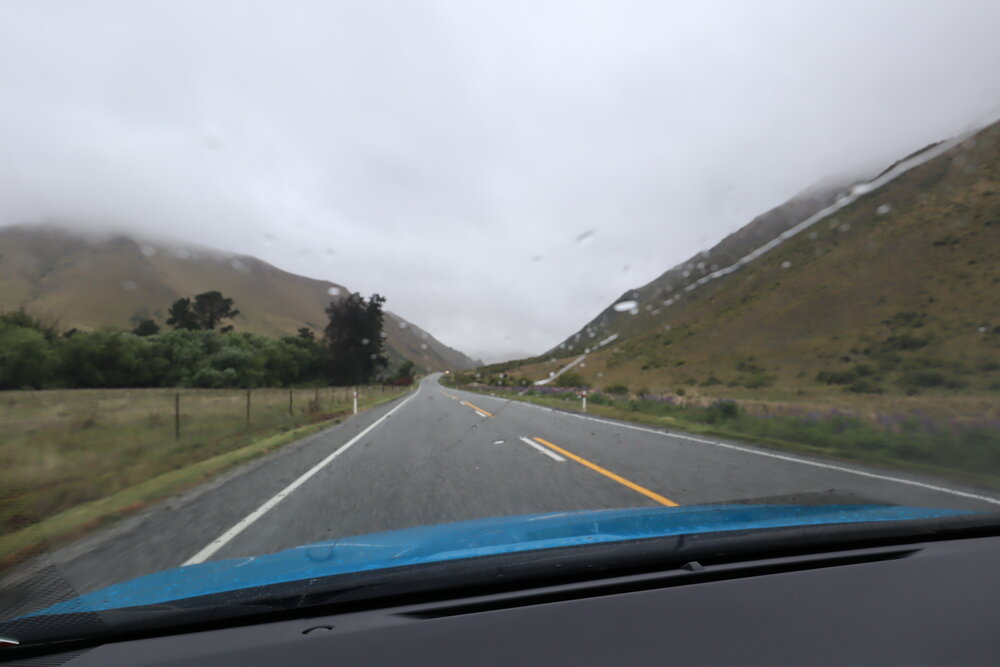
Driving in New Zealand
(As you’d expect from Kiwis, they’re pretty understanding about the whole thing too. We committed one error during the entire trip, making an illegal right-turn into the wrong lane, and the driver in the lane that we had turned into could only crack a wry smile.)
Driving in New Zealand is mostly pretty peaceful, and despite the region’s popularity among tourists, you aren’t very likely at all to get into long traffic queues on the road.
You’re likely to see lots of roadkill, though: the country continually struggles with a pest problem, with rats, stoats, and possums wreaking havoc on their unique biosphere, so tourists are encouraged to play their part by flattening as may of these pesky creatures as possible as they drive.

Driving in New Zealand
Oh, and there was also the time when a police convoy travelling in the opposite direction asked us to pull over because a house was being driven down the road.
Yes, an entire house had been placed on four wheels, and we saw it coming down the highway. I can’t make sense of it either.

“A house is coming down the road.”
Milford Sound & Te Anau
Te Anau is a sunny and sleepy town that primarily serves the many tourists that descend upon this area to visit the famous Milford Sound, and I thought it was a welcome reprieve from the fast-paced city life I’m accustomed to as we pulled into its quiet residential streets towards our Airbnb.

Airbnb in Te Anau
We had chosen a charming guest house at the end of a cul-de-sac for our two-night stay, which had everything we needed: kitchen, washer-dryer, sitting area, and even an outdoor trampoline and a piano. We spent the first evening watching the sunset over a light home-cooked meal, looking out over the wheat field right by the house and listening to the gentle summer breeze, and it was perfect.

Airbnb in Te Anau
The next day, it was time to head to the scenic fiords of Milford Sound on our boat and hiking tour, but there was one problem: there was an almighty downpour.
The tour would proceed rain or shine, though, and our guide picked us up early in the morning for the hour-long drive from Te Anau to Milford Sound. Alas, the rain hadn’t cleared up by the time we embarked on the boat tour, so our visibility during the tour would unfortunately be quite limited.

Milford Mariner boat cruise
Every rain cloud, in this case, comes with a silver lining: even though our views of the famously rough coastline were limited by the rain, we did get to see dozens of “temporary waterfalls” as a result, which wouldn’t have been there were it not for the heavy rainfall.

Milford Mariner boat cruise

View of Milford Sound waterfalls
Our boat took us through the entire span of Milford Sound and out into the open oceans of the Tasman Sea before turning back. Along the way, we visited a few famous waterfalls – most notably Lady Bowen Falls, the tallest; and Stirling Falls, where our boat perched up virtually directly underneath the falls, and we were invited to get up close and personal.

Stirling Falls, Milford Sound
We also caught a view, however foggily, of Mitre Peak, the distinctively shaped mountain peak right on the shores of the fiord.

Mitre Peak, Milford Sound
Overall, while sunny weather would’ve been preferable, the boat journey through a heavily storm-lashed Milford Sound was certainly one to remember. For $130 per person including lunch, the car transfer both ways, and the afternoon hike, I thought it was decent value.
Luckily, the rain cleared up in the afternoon, allowing our group to tackle a few walking tracks and chase some smaller waterfalls on the way back to Te Anau. Our guide, an older British man who now lives in Te Anau, was incredibly knowledgeable too, educating us on everything we saw along the way, from the flora species that we encountered along the track, to the specific poison-dropping methods used to combat New Zealand’s pest problems.
On our final day in the region, we headed to the Te Anau Bird Sanctuary to catch a glimpse of the takahe, a flightless bird that was thought to be extinct for 50 years until a tiny colony was discovered in the South Island’s highlands.
[foogallery id=”16686″]
Make sure to come around 10am for the feeding hour, which allows you to see the takahe up close and listen to their birdsong; otherwise, you’ll need to circle the pen and crane your neck quite a bit to get a glimpse of the silly little creatures.
(Speaking of birds endemic to New Zealand, I wouldn’t be doing the country justice if I didn’t pay homage to the playful kea birds that love to clown around with humans. And while Jessy and I kept our eyes peeled for any chance of spotting a kiwi bird on the whole trip, we sadly didn’t manage to see one.)

The kea bird!
After seeing the takahe, we took a picnic lunch around the walking track by Lake Te Anau, before embarking on the drive back to Queenstown in the afternoon.

Lake Te Anau
Mount Cook & Lake Tekapo
Three hours north of Queenstown, in the South Island’s heartland of Mackenzie Country, are the mighty peaks of Mount Cook (also known by its Maori name, Aoraki) and the fluorescent blue waters of Lake Tekapo.
Meanwhile, the similarly fluorescent Lake Pukaki and the nearby town of Twizel are equidistant between the two, making it an ideal home base for touring this region.
Instead of staying in the town, though, Jessy and I opted for something a little more rustic: a refurbished plane Airbnb which sat right next to the tarmac of Pukaki Airport, a private airstrip.
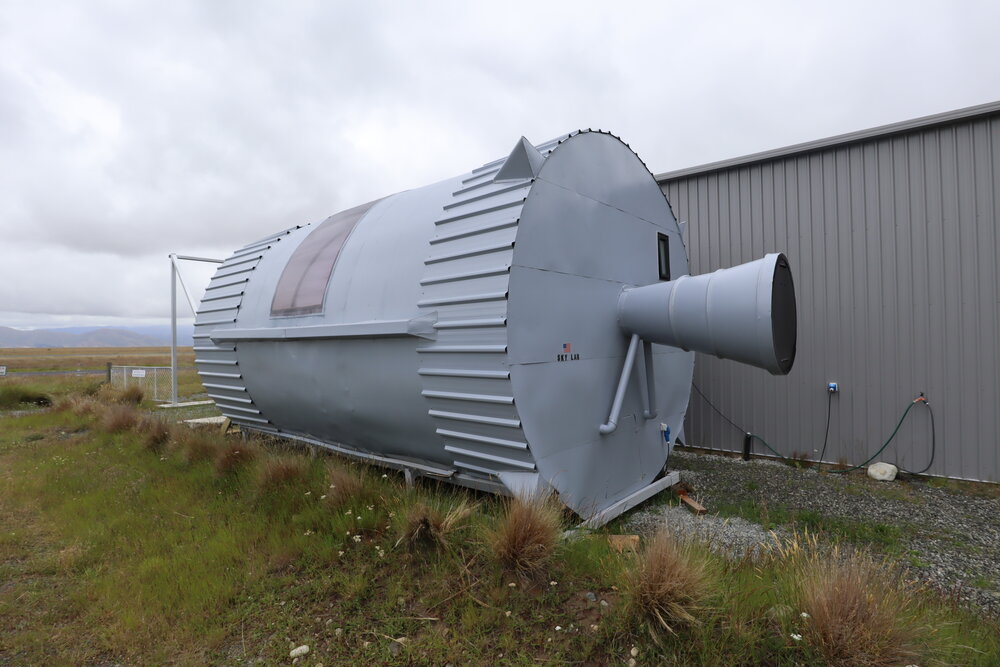
Airbnb in Pukaki Airport

Airbnb in Pukaki Airport
This was definitely one of the most unique accommodations I’ve tried in recent years, and even though it was pretty cozy in there with not a lot of amenities, we managed to get by just fine – after all, the town of Twizel was only a five-minute drive away with everything we needed.

Airbnb in Pukaki Airport
Our first day in the region brought us to Mount Cook, the highest peak in New Zealand. There’s one point along the drive, where you turn a corner and all of a sudden find yourself on a straight-shot to the mountain, with its colossal peaks towering over you, bestowing upon you the most acute sense of insignificance.

Aoraki / Mount Cook
While we wouldn’t be scaling those peaks this time around – that’s a strenuous six-day climb for those who actually know what they’re doing – we aimed to conquer as many walking tracks along the base as we could.
Across valleys, rivers, and suspension bridges, we made it to the Hooker Glacier, a glacial lake that provides sweeping views of the Aoraki peak from its shores. Jessy even fell asleep for a brief nap on one of the rocks here, which I thought was hilarious.

Hooker Valley Glacier Walk, Mount Cook

Hooker Valley Glacier Walk, Mount Cook

Hooker Glacier, Mount Cook
In the afternoon, we hiked up to the Tasman Glacier, a much larger lake formed by the recent glacial retreat.
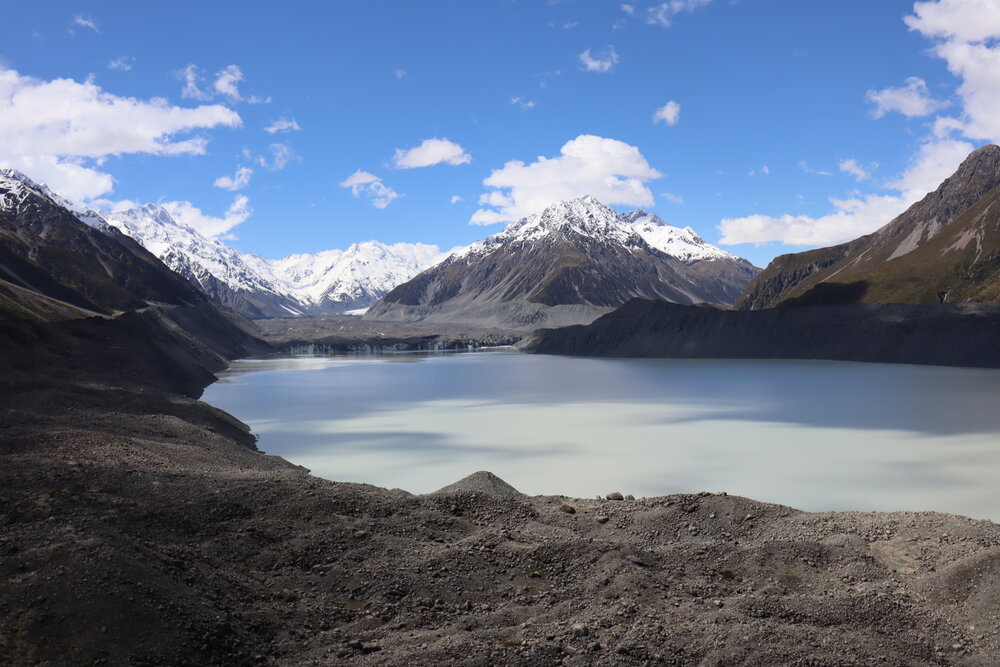
Tasman Glacier, Mount Cook
The next day took us along the eastward fork in the road towards Lake Tekapo, a scenic leisure spot in the heart of Mackenzie Country known for its lupin fields. The distinctive pink and purple flowers, set against the impossibly blue waters with the Southern Alps in the distance, make for a lakeside resort town that’s exceedingly easy on the eye.
[foogallery id=”16690″]
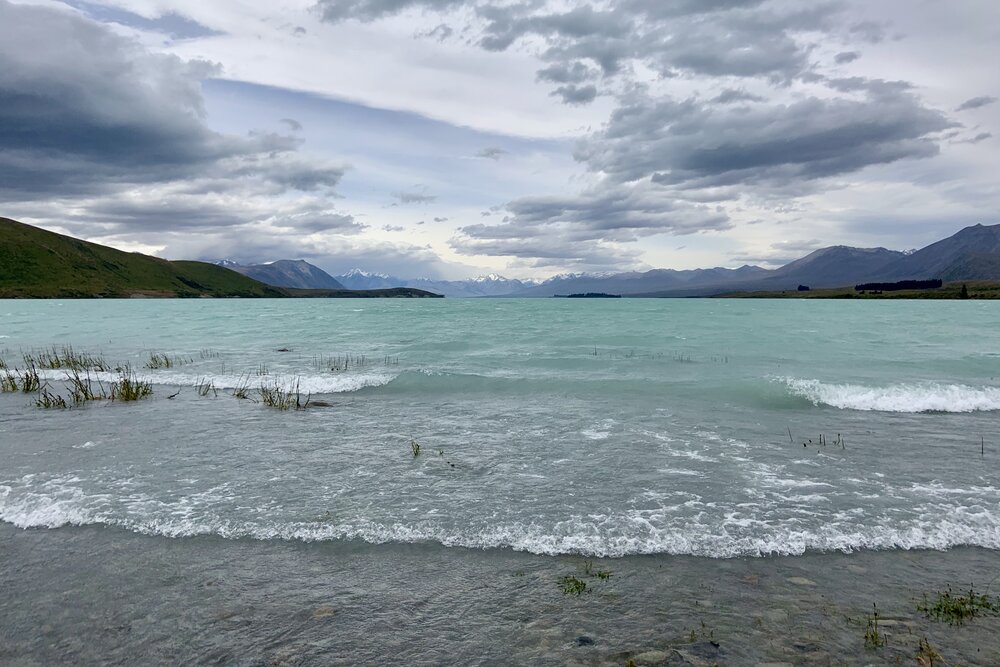
Lake Tekapo
It was a particularly windy day, though, so we didn’t spend too much time on the lake, and we instead spent most of the day at the Tekapo Springs for an unexpected spa retreat among the heated pools. Jessy and I aren’t normally big spa people, but here in the light rain with some incredible views before us, it was a welcome way to unwind.
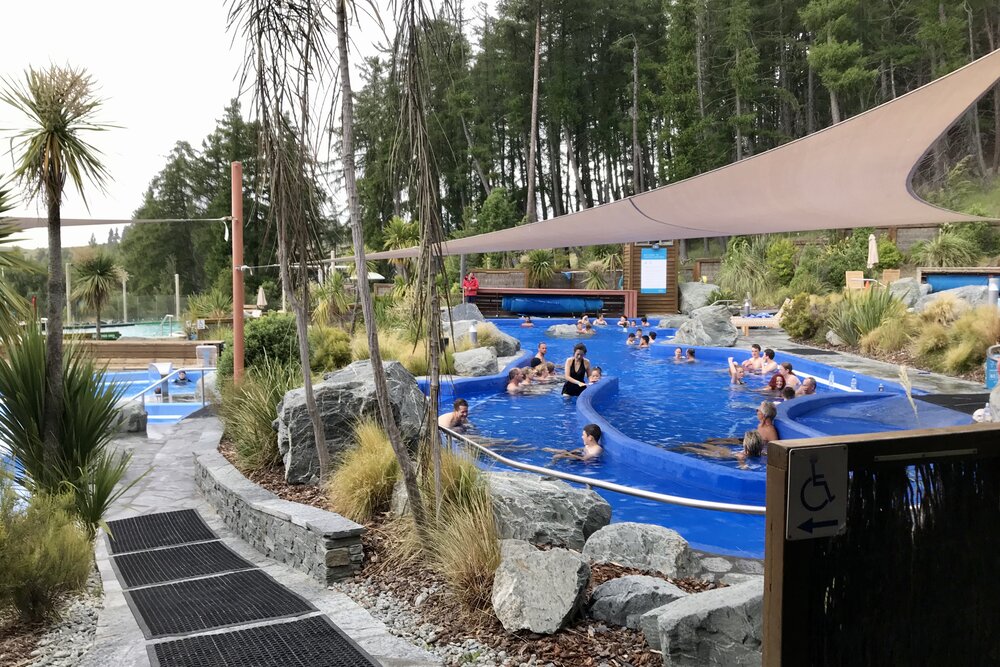
Tekapo Springs
Before that, we had also taken a tour through the International Dark Sky Reserve on the lakeshore, an exhibition detailing the Mackenzie Basin’s efforts to restrict light pollution and ensure the stars are visible in the night sky, while also informing us of the Maori mythology behind each of the constellations.
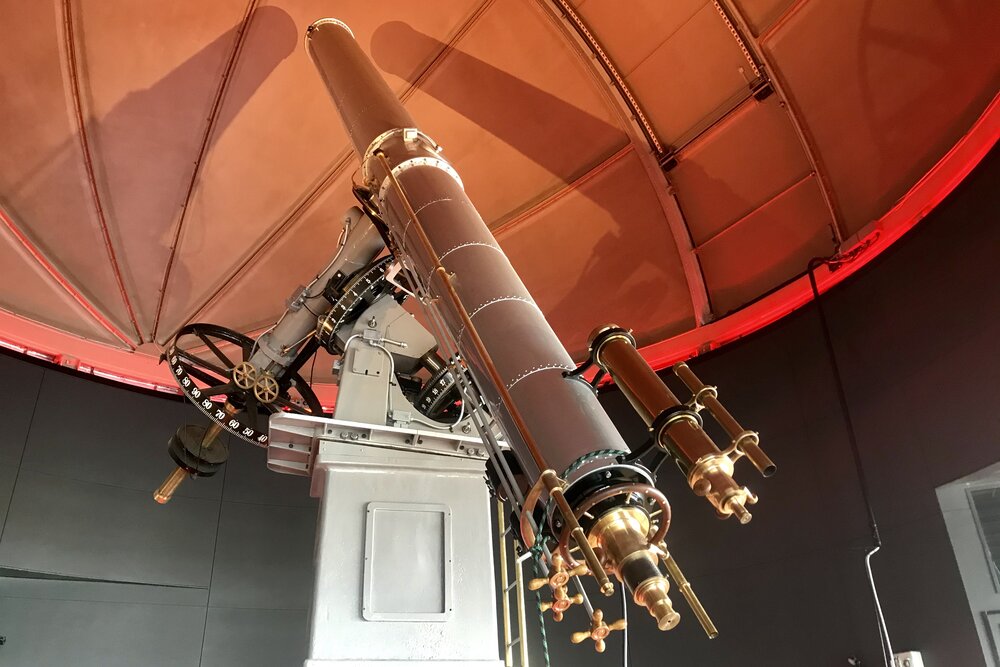
International Dark Sky Reserve, Lake Tekapo
And speaking of the stars, our abandoned plane Airbnb came with a skylight to look through the ceiling, and we could of course stargaze right outside – and even directly on the airstrip’s tarmac – as well.
These were the clearest night skies that I can recall seeing since the United Island Hopper, and that sensation of getting lost among the stars while drifting off to sleep is not one that we’ll soon forget.
Queenstown, The World’s Adventure Capital
Our time in the South Island would come to an end with a few days in Queenstown, one of New Zealand’s foremost resort towns on the shores of Lake Wakatipu.
Queenstown is, quite simply, blessed with otherworldly natural beauty. A hike to the summit of Queenstown Hill is highly recommended, affording you 360˚ views of the city and the surrounding landscape, where rolling hills and glimmering waters blend into each other in a fantasy-like setting.

Queenstown Hill Summit

Queenstown Hill Summit
There’s an endless list of things to do in Queenstown to keep you occupied: wine tasting in the summer, skiing in the winter.
Most of all, though, Queenstown is known for its adventure tourism: travellers from all over the world come here to experience an adrenaline rush like no other, with jet boating, paragliding, mountain biking, and skydiving all on the cards.
For my part, after looking over all the possibilities, I decided that I’d be more than happy with checking off a major bucket list item during my time here: bungee-jumping for the first time at the Kawarau Bridge Bungy, the world’s first-ever commercial bungee jump.
(The Kiwis basically invented the sport, you know, so I knew I wouldn’t be doing this place justice if I didn’t partake.)

Kawarau Bridge Bungy
I’ve always wondered what it would be like to bungee jump, and in particular whether I’d be able to go through with it when I’m standing right there at the ledge. I was wrought with anxiety in the days leading up to the jump, constantly flip-flopping between whether to book the bungee jump or whether to chicken out.
On the night before we left Queenstown, I went ahead and made the purchase. I was now NZ$235 ($196) in the hole, so I’d see a good chunk of money down the drain if I were to chicken out now. Needless to say, that was no longer an option.
It’s hard to describe the emotions when you’re standing in line for your first bungee jump. They say the fear of public speaking is the strongest fear out there, but I would’ve happily given 1,000 TED Talks not to be there in that moment.

Kawarau Bridge Bungy jumping platform
There comes a point, though, between stepping down onto the platform and your final equipment check, where you’re simply overcome by a sense of acceptance: you’re jumping, no matter what. You’re plunging to the earth attached to nothing but a piece of rope, and that’s just what’s going to happen – there’s no two ways about it.
After that moment, the rest of the experience was a total blur.
Nary a second after the jumpmaster called “Bungeeee!”, I extended my arms, slammed my eyes shut, and leapt off the platform, screaming at the top of my lungs for dear life.
The downright terrifying sensation lasted no more than a few seconds, as the elasticity of the rope ensuring that I swung back upwards in a smooth motion. By this point, I was bouncing around in the air and laughing like a maniac, an unimaginable range of emotions swelling within me as I came to terms with checking off one of the most significant accomplishments on my personal bucket list.
Conclusion
Whether it’s the dramatic fiords of Milford Sound, the gorgeous land and water of the Mackenzie Basin, the starry summer nights under the Southern Cross, or taking that ultimate leap of faith, this trip well and truly solidified New Zealand as one of my favourite countries in the world, and a South Island road trip is something I’d recommend to anyone who has an interest in exploring the great outdoors by road.
Peaceful long drives through rolling hills and lupin fields were a welcome change of pace from most of the trips I take, and we definitely intend to return for many more visits to New Zealand in the future, perhaps to discover more of the North Island next time, or to walk the famous Milford Track – the “finest walk in the world” – when we’ve clocked up some more hiking experience.















Looking back on this for inspiration as I just put the finishing touches on a trip to NZ for January 2022!
I hope it all works out Eric – we reminisce about this NZ trip very often since it was our last period of extended travel before COVID happened.
Fantastic post Ricky. Just one minor point – Auckland isn’t the capital, it’s Wellington at the south end of the North Island.
Thanks, I should know this. Largest city it is.
Great trip report Ricky! These kind of posts are actually my favourite to read. Looking forward to visiting NZ someday.
Great post, Ricky! I’m so glad you and Jessy enjoyed your time in New Zealand. This brought back wonderful memories of my own NZ road trip at this time last year. We had six weeks to explore both islands (four on the South Island and two on the North). Definitely do a Great Walk next time you go! We did the Kepler Track (which starts and finishes just outside of Te Anau) and it was spectacular. I’d love to go back for several months and tackle the other nine – although with hut accommodations costing double for non-Kiwis, I might need to pick just a few 🙂
The Kepler Track was the one we did by Lake Te Anau – I had forgotten the name so thanks for reminding me 🙂
There remains much to see and conquer in NZ. I’m jealous of the six weeks you spent there, that sounds amazing!